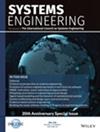提高AADL模型的一致性:一种组合方法
IF 1.6
3区 工程技术
Q4 ENGINEERING, INDUSTRIAL
引用次数: 0
摘要
aadl体系结构分析和设计语言已被证明在开发实时嵌入式系统中非常重要。然而,它的形式化能力仍然有限,这使得难以产生一致的模型;特别是在几个模型组合在一起的情况下。因此,使用形式化验证是满足AADL模型一致性要求的有效途径。本文提出了一种基于模型的工程方法,该方法使用时间自动机(TA)形式化将多个AADL模型聚合为单个复合模型。该方法基于输入AADL模型集,创建一致的组合模型,并支持模型检查验证。通过两个案例研究来评价这一贡献的有效性;多摄像头监控系统和无人机系统。本文章由计算机程序翻译,如有差异,请以英文原文为准。
Improving consistency of AADL models: A composition approach
AADL—architecture analysis and design language—has proven to be important in developing real‐time embedded systems. However, its formalization capability is still limited, which makes it difficult to produce a consistent model; particularly, in the case where several models are combined together. Therefore, using formal verification is an effective way to meet the consistency requirements of the AADL model. This paper proposes a model‐based engineering approach that uses timed automata (TA) formalism to aggregate multiple AADL models into a single composite model. Based on the set of input AADL models, the proposed approach creates a consistent composed model as well as support model checking verification. The effectiveness of this contribution is evaluated through two case studies; a multicamera surveillance system and a drone system.
求助全文
通过发布文献求助,成功后即可免费获取论文全文。
去求助
来源期刊

Systems Engineering
工程技术-工程:工业
CiteScore
5.10
自引率
20.00%
发文量
0
审稿时长
6 months
期刊介绍:
Systems Engineering is a discipline whose responsibility it is to create and operate technologically enabled systems that satisfy stakeholder needs throughout their life cycle. Systems engineers reduce ambiguity by clearly defining stakeholder needs and customer requirements, they focus creativity by developing a system’s architecture and design and they manage the system’s complexity over time. Considerations taken into account by systems engineers include, among others, quality, cost and schedule, risk and opportunity under uncertainty, manufacturing and realization, performance and safety during operations, training and support, as well as disposal and recycling at the end of life. The journal welcomes original submissions in the field of Systems Engineering as defined above, but also encourages contributions that take an even broader perspective including the design and operation of systems-of-systems, the application of Systems Engineering to enterprises and complex socio-technical systems, the identification, selection and development of systems engineers as well as the evolution of systems and systems-of-systems over their entire lifecycle.
Systems Engineering integrates all the disciplines and specialty groups into a coordinated team effort forming a structured development process that proceeds from concept to realization to operation. Increasingly important topics in Systems Engineering include the role of executable languages and models of systems, the concurrent use of physical and virtual prototyping, as well as the deployment of agile processes. Systems Engineering considers both the business and the technical needs of all stakeholders with the goal of providing a quality product that meets the user needs. Systems Engineering may be applied not only to products and services in the private sector but also to public infrastructures and socio-technical systems whose precise boundaries are often challenging to define.
 求助内容:
求助内容: 应助结果提醒方式:
应助结果提醒方式:


